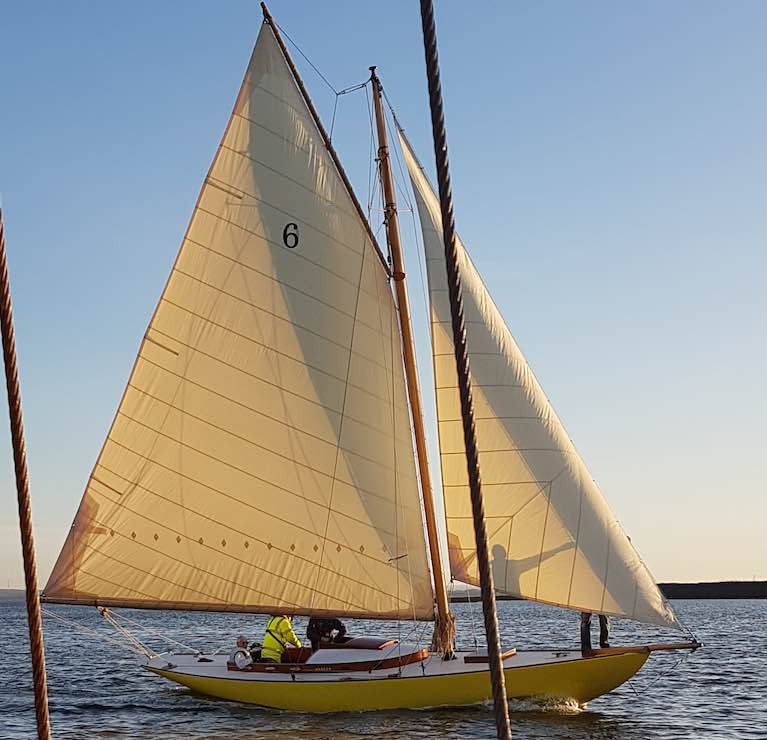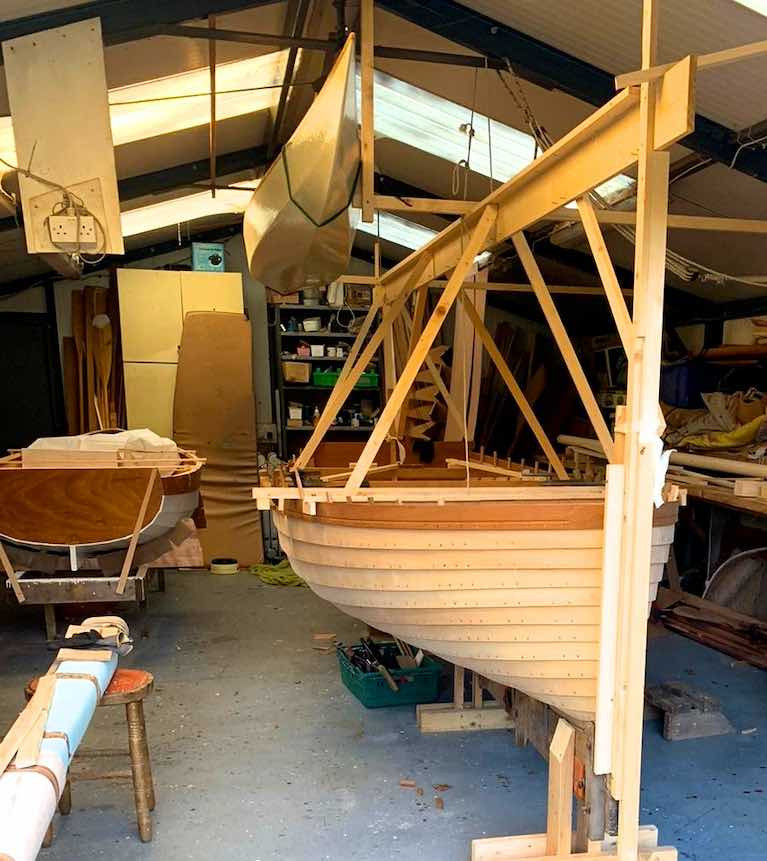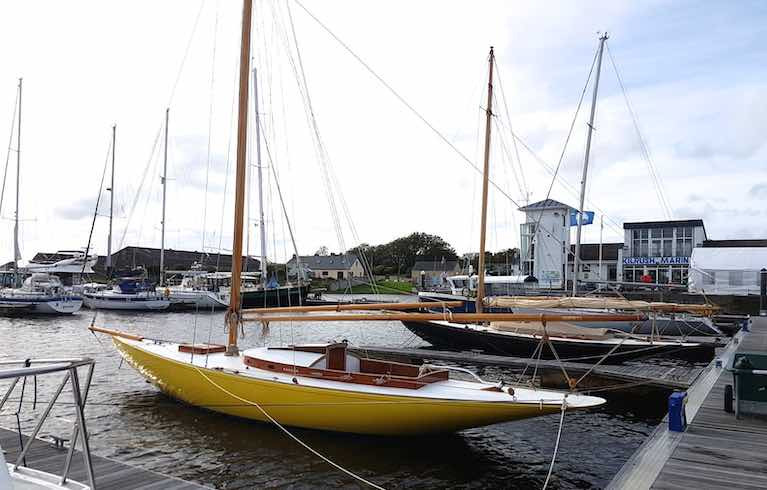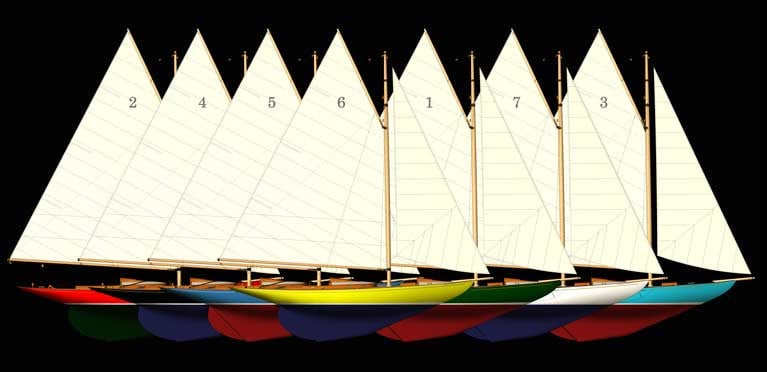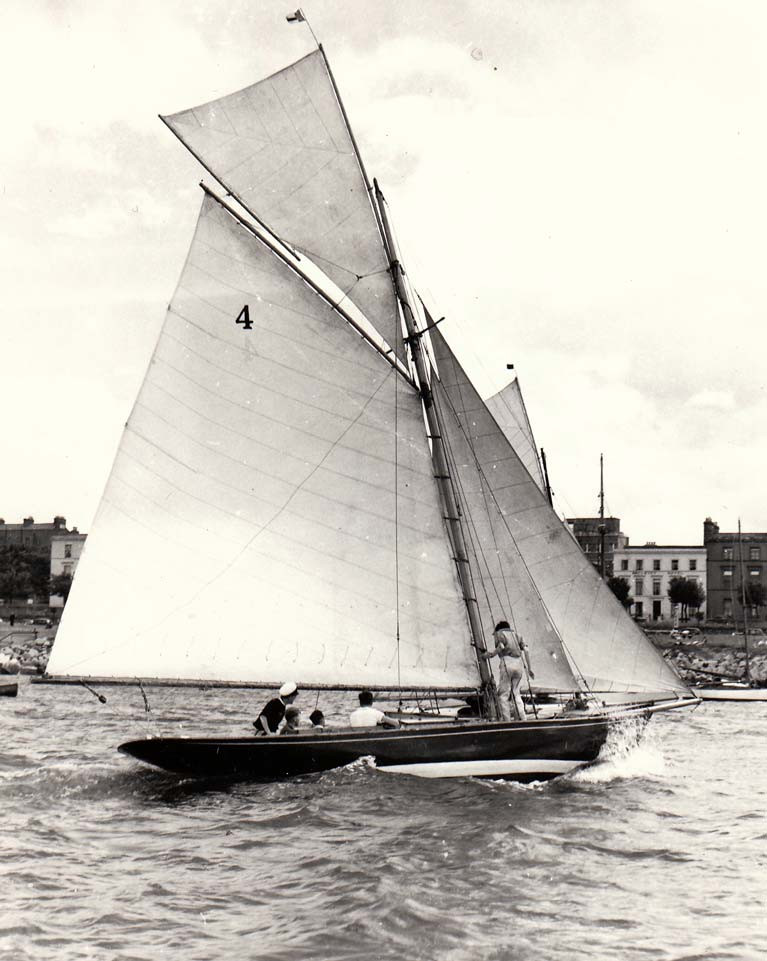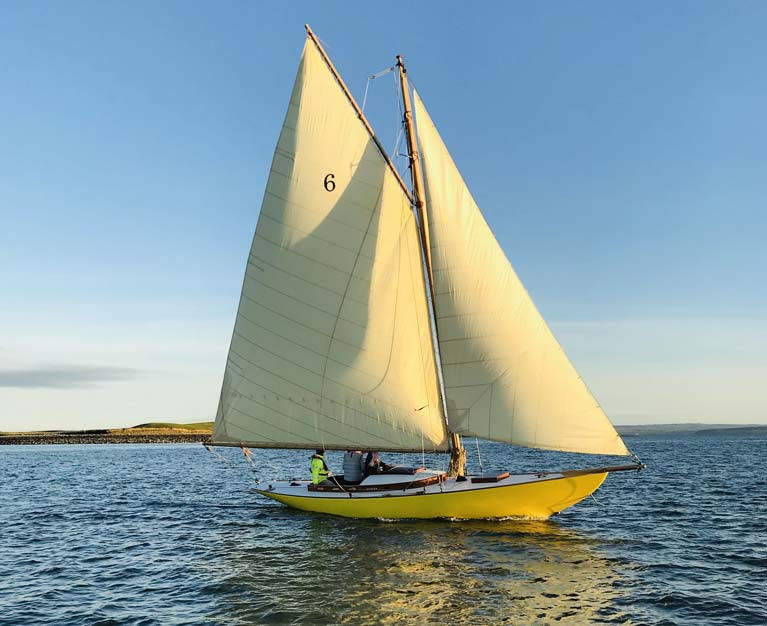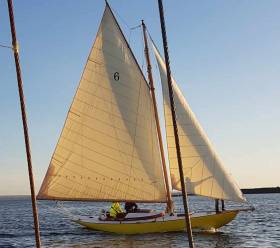Displaying items by tag: Dublin Bay 21
The Dublin Bay Twenty-Ones Are Coming Home: 30 July 2021, Dun Laoghaire Harbour 1700hrs
The Dublin Bay 21 Footers are the oldest class of racing yachts of their kind in the world - the World’s Oldest Cruiser Racer Class. Designed in 1902 by the leading yacht designer, Alfred Mylne of Glasgow, for Dublin Bay Sailing Club, seven were built between 1903 and 1908 and all seven still survive.
Originally gaff-rigged with large topsails, the boats were converted to a Bermudan rig in 1964 and continued to race in Dublin Bay until 1986, by which time major structural restoration work was required. The owners agreed to have the boats restored to their original gaff rig by Tyrrells of Arklow. Five boats were transported to Arklow by road while Garavogue and Geraldine made their way under sail. Following the death of Jack Tyrrell in 1988 and the subsequent closure of the famous Shipyard, the fleet was laid up in a farmyard near Arklow until the present project began in 2017 with the formation of the Dublin Bay 21 Footer Class Association and the transfer of ownership of all boats to the Association.
The Association is committed to the revival of the class and now for the first time since 1986, the Class will participate in the DBSC racing programme of 2021. The boats will sail under the modified gaff rig designed by Alfred Mylne in 1918. For a generation born in the digital age, beguiled by novelty and speed, the Dublin Bay Twentyones are a reminder of how beautiful a true sailing boat can be. The boats will provide an opportunity for present day sailors to experience the sailing characteristics of a truly authentic classic yacht. The boats will carry a crew of 5 or 6.
Master boatbuilder Stephen Morris and his team in Kilrush in County Clare have produced an outstanding example of authentic wooden boat restoration. Using Alfred Mylne’s original drawings, supplemented by construction details provided by Naval Architect, Paul Spooner, the traditional skills of the shipwright have been combined with the latest technical knowledge in timber conservation and construction methods. The use of laminated beams and frames and epoxy resins has resulted in stiff, water tight, low maintenance, monocoque hulls, without nails or screws, which allows the application of durable two-pack polyurethane finishes. The original lead keels. iron tillers and fittings have been reused together, with some of the original greenheart and pitch pine timbers.
 Hal Sisk gives a a pre-departure briefing on the quayside at Arklow on Friday morning, July 30 at 0800 hours
Hal Sisk gives a a pre-departure briefing on the quayside at Arklow on Friday morning, July 30 at 0800 hours
 The Dublin Bay Twenty One Naneen underway and heading back to Dun Laoghaire Harbour
The Dublin Bay Twenty One Naneen underway and heading back to Dun Laoghaire Harbour
The first three restored 21’s Number 3 Estelle, 4 Garavogue and 6 Naneen will sail from Arklow tomorrow (Friday 30th) July to arrive at Dun Laoghaire at 17.00 where they will be met by the Dublin Bay Sailing Club flag-ship Mac Lir to a gun salute. The arrival may be viewed from The East Pier Dun Laoghaire Harbour, and if conditions suit, the returned DB21s will lead a flotilla of classics on a circuit of Scotsman's Bay before entering Dun Laoghaire harbour for an official reception at the National Yacht Club.
 Naneen restored - she was the first of the Dublin Bay 21s to be brought back to life as part of the new project.
Naneen restored - she was the first of the Dublin Bay 21s to be brought back to life as part of the new project.
Return of Dublin Bay 21s During Olympics Shows Sailing in Ireland is a Matter of Shared Interests
The start of the Sailing Olympics tomorrow (Sunday) at Enoshima, fifty kilometres from central Tokyo, may seem to be the beginning of a boat event about as different as humanly possible from the staging next Friday (July 30th) of an informal classics regatta at Dun Laoghaire to welcome home the first three restored Dublin Bay 21s.
The DB21s last raced in Dun Laoghaire in August 1986, and their re-birth - thanks to Fionan de Barra and Hal Sisk, using the brilliant skills of Steve Morris of Kilrush Boatyard – is beyond miraculous. It's something that will be joyously celebrated as they sail into Scotsmans Bay next Friday afternoon, welcomed by a remarkable assembly of classic Water Wags, Howth 17s, and Glens, with the possibility of other boats also involved.
 The restored Naneen sailing off Kilrush. She was built in 1905 by James Clancy of Dun Laoghaire for Cosby Burrowes (1856-1925) of Crossdoney, Co Cavan, who was a serial Dublin Bay One Design owner. He had at least one Water Wag, he also owned one of the original Mermaids of 1891, in 1892 he had a One Rater (also built by Clancy), and in 1899 he commissioned the Dublin Bay 25 Nance, the only DB25 built in the boatyard of the designer William Fife III. Like Naneen, Nance still sails, but now in Dutch ownership under the name of Iona.
The restored Naneen sailing off Kilrush. She was built in 1905 by James Clancy of Dun Laoghaire for Cosby Burrowes (1856-1925) of Crossdoney, Co Cavan, who was a serial Dublin Bay One Design owner. He had at least one Water Wag, he also owned one of the original Mermaids of 1891, in 1892 he had a One Rater (also built by Clancy), and in 1899 he commissioned the Dublin Bay 25 Nance, the only DB25 built in the boatyard of the designer William Fife III. Like Naneen, Nance still sails, but now in Dutch ownership under the name of Iona.
 Departure lounge? Not quite, but for years things didn't look too hopeful for Naneen in this Wicklow farmyard.
Departure lounge? Not quite, but for years things didn't look too hopeful for Naneen in this Wicklow farmyard.
 Steve Morris and Fionan de Barra in Naneen's restored interior. Despite the sparse comfort and limited headroom, several of the boats were used for cruising in the early years of the class. Photo John Kelly/Clare Champion
Steve Morris and Fionan de Barra in Naneen's restored interior. Despite the sparse comfort and limited headroom, several of the boats were used for cruising in the early years of the class. Photo John Kelly/Clare Champion
Some will be classic or traditional and some not. But either way, they'll demonstrate that, in order to fully savour the Irish sailing experience, you have to be broad-minded in your interests and enthusiasms - you have to see there's a bigger picture involved with inter-connections every which way.
For sure, there won't be anyone present who isn't be accessing the latest Olympic sailing news from Japan now and again. But with the classics, you can take the long view. After all, the Water Wags as a class had already been in being for nine years when the modern Olympics were introduced in in 1896. The Howth 17s had started racing just two years later. And the Dublin Bay 21s were racing five years after that.
 The Water Wags shaping up for a start on Wednesday evening this week. In the foreground is one of the latest additions to the class, No 50 (Mandy Chambers), which was constructed in the Albeola Boat-Building School in San Sebastian in Spain. Photo by Ann Kirwan (Commodore, DBSC)
The Water Wags shaping up for a start on Wednesday evening this week. In the foreground is one of the latest additions to the class, No 50 (Mandy Chambers), which was constructed in the Albeola Boat-Building School in San Sebastian in Spain. Photo by Ann Kirwan (Commodore, DBSC)
With such a vigorous history, all Ireland's local sailing inevitably made an input into our Olympic sailing teams. Of course, the sailors involved had re-configured their skills with training in the relevant Olympic boat. But our first Olympic squad in 1948 was made up of the two-man Swallow sailed by Alf Delany (Dublin Bay Water Wags and Shannon One Designs) and Hugh Allen (IDRA 14), while the Firefly used for the singlehanded contest was sailed by Jimmy Mooney. He'd had a short time to train up with Fireflies in Dun Laoghaire, but before that he'd acquired a formidable reputation racing the classic clinker-built International 12s when the Mooney family lived and sailed in Howth, where his father Billy had been a noted helm in the Howth 17s.
This reliance on skilled potential Olympians emerging from local classes such as the Dublin Bay 21s is a fact of life, because the only two long-term Olympic boats which have achieved significant numbers at Irish clubs are the now Olympically-discontinued International Dragon keelboat, and - since 1996 – the Laser, hugely popular and still seeming as fresh as a daisy after more than fifty years on the scene, a remarkable score underlined by that the fact that the boat's characterful designer, the great Bruce Kirby, died much-mourned this week at the fine age of 92.
 A recent photo of the late Bruce Kirby. His inspired design for the Laser created a unique boat which met Olympic requirements while acquiring universal popularity
A recent photo of the late Bruce Kirby. His inspired design for the Laser created a unique boat which met Olympic requirements while acquiring universal popularity
World-wide, it is the Laser's universality of appeal which gives its Olympic role a special cachet, something intensified in Ireland as our only recent Olympic sailing medal – the Silver in the 2016 Rio Games – was taken by Annalise Murphy in the Women's Laser Radials, and she's defending in Japan.
She's from a family immersed in many aspects of Irish sailing – her mother Cathy Mac Aleavey campaigned the Womens 470 in the Seoul Games in 1988. Yet in current Dun Laoghaire sailing, Cathy and husband Con Murphy, an International Race Officer, are currently best known as stalwarts of the Water Wag Class.
Thus as she's sailing alone, it is Annalise who will most acutely feel the high level of isolation in Japan, with her usually highly-supportive family forced to stay pandemic-separated on the other side of the world. But as this photo taken in the car on the way to the airport to send Annalise on her way to Japan a while back reveals, they're all determined to put a cheerful face on it.
 Poignant moment. Cathy MacAleavey, Con Murphy and Annalise Murphy on their way to Dublin Airport and Annalise's departure alone for the Olympics
Poignant moment. Cathy MacAleavey, Con Murphy and Annalise Murphy on their way to Dublin Airport and Annalise's departure alone for the Olympics
Our other hopes closest to home are Sean Waddilove of Skerries and Rob Dickson of Howth in the International 49er skiff. Sometimes known as the Fingal Flyers, they're a reminder that Fingal has had one of Ireland's fastest-growing populations for quite some time now, and with its long coastline and several sailing centres, eventually completely new talent was going to emerge, and that was what happened when Sean Waddilove came out of a Learn to Sail initiative at Skerries Sailing Club.
Rob Dickson by contrast is a cradle sailor from the Howth peninsula, and a grandson of the late great Roy Dickson, thus he and Sean call their Boat of the Moment "Cracklin' Rosie". Rob is well rooted in Sutton and Howth dinghy racing, with the occasional Lough Ree flavouring, so he and Sean – when set into the total Irish Olympic Sailing Squad for Enoshima with Annalise Murphy – provide a truly representative lineup of classic and modern Irish sailing.
 Rob Dickson, Taoiseach Leo Varadkar and Sean Waddilove in Howth Yacht Club after Rob and Sean had won the 49er U23 Worlds in September 2018.
Rob Dickson, Taoiseach Leo Varadkar and Sean Waddilove in Howth Yacht Club after Rob and Sean had won the 49er U23 Worlds in September 2018.
Olympic sailing has now become so highly specialised that, regardless of the diversity of boat backgrounds from which potential Irish Olympians might emerge, when it's one of the two-people boats involved it can be extremely difficult, in a small population like ours, to find a matching talent with the requisite enthusiasm and complete dedication.
This was the problem faced by Saskia Tidey of Dun Laoghaire after she and Andrea Brewster came 14th for Ireland in the 49erfx in 2016. Tidey was keen to go on towards Tokyo, but there was no-one available to match her total ambition in the small pool of Irish performance sailing. So she teamed up with Charlotte Dobson of Scotland and they'll be sailing for GB in Enoshima, and much and all as we'd prefer it if she was sailing for Ireland, it would be a very mean-spirited soul who didn't wish her well.
By the time the first three restored DB 21s are making their way into Dun Laoghaire next Friday evening, the Olympic picture will be clearer despite the intensifying heat haze in Japan, where the good news for sailors is that while the main venues in Tokyo are experiencing temperatures of 35 with a humidity count of 95, down the coast at Enoshima it's all a bit fresher, but nevertheless everyone now knows why the 1964 Summer games – which introduced the Olympics to Japan – were staged in October.
 Walking the course……classics enthusiasts Guy Kilroy (left) and Hal Sisk testing the waters of Scotsman's Bay on Thursday of this week on board the former's 24ft 1896-built Boyd gaff sloop Marguerite, restored by Larry Archer. Photo: Ian Malcolm
Walking the course……classics enthusiasts Guy Kilroy (left) and Hal Sisk testing the waters of Scotsman's Bay on Thursday of this week on board the former's 24ft 1896-built Boyd gaff sloop Marguerite, restored by Larry Archer. Photo: Ian Malcolm
Meanwhile, in Dublin Bay the re-born DB 21s are arriving in on Friday not to suit some global TV schedule, but because the time was right, the tide to bring them up from Arklow suited, and the good work can go on. For one of the trailers which was used to bring the finished boats from Kilrush returned to County Clare with the very tired hull of the DB21 Geraldine – for years associated with the Johnston family – in order for Restoration 4 to begin.
Dublin Bay 21s’ Restoration Will See the Sleeping Beauties Awake Again In Dun Laoghaire on July 30th
Although the more energetic clubs managed successful if very compressed programmes in the brief permitted sailing season of 2020, the pandemic shut-down was so all-encompassing for life in general that it’s taking quite some time to get a proper feeling that the programme for 2021 really has the potential to develop as the season makes on.
The fact that today we’re in the mild melancholy which comes on for the day or two after the Summer Solstice contributes to the mood, with some sailors peering muzzily out at the horizon like Rip van Winkle after his twenty years of sleep.
 Garavogue in her heyday under her original rig in Dun Laoghaire Harbour sixty years ago.
Garavogue in her heyday under her original rig in Dun Laoghaire Harbour sixty years ago.
But their challenge of adjustment is as nothing compared to those whose ideal vision of a sailing boat is the Dublin Bay 21. This 1902 Alfred Mylne-designed class last raced out of Dun Laoghaire in August 1986. So when the first three newly-restored boats re-appear at the National Yacht Club on Friday July 30th, we’ll be thinking in terms of the Sleeping Beauty and her century of zizz, rather than Rip van Winkle and his afternoon nap of twenty years.
 Naneen pre-restoration in Kilrush with (left to right) Fionan de Barra, Steve Morris, design consultant Paul Spooner, and Hal Sisk
Naneen pre-restoration in Kilrush with (left to right) Fionan de Barra, Steve Morris, design consultant Paul Spooner, and Hal Sisk
Admittedly it’s “only” 35 years since they last raced, but it sometimes does seem like a hundred, and many people had resigned themselves to the permanent disappearance of the class. It is only thanks to Fionan de Barra keeping the faith with the major solution-finding input of Hal Sisk - allied to the remarkable skills of boatbuilder Steve Morris of Kilrush – that we can now admire Naneen and Garavogue already sailing in the Shannon Estuary, while their sister-ship Estelle – originally built by Hollwey of Ringsend in 1903 for Herbert Wright, who in 1929 became founding Commodore of the Irish Cruising Club – will soon also be afloat.
For their final decades, the Twenty-Ones were almost completely focused on the National Yacht Club, so at the moment – for who can say if any proposed date is a fixture these days - the date of Friday July 30th 2021 has been set for the Twenty-one Foot Class’s sleeping beauties Naneen, Garavogue and Estelle to be re-awakened at the National Yacht Club. It will only a need a kiss from the most appropriate neighbourhood prince, but there’s no word yet as to whether auditions are planned for that special role……
 Naneen - Dun Laghaire-built in 1905 - demonstrates her timeless elegance on her maiden sail in restored form
Naneen - Dun Laghaire-built in 1905 - demonstrates her timeless elegance on her maiden sail in restored form
The continuing restoration of the Dublin Bay 21 class of 1902, in the longterm project guided by Hal Sisk and Fionan de Barra of Dun Laoghaire, has seen the work of Master Shipwright Stephen Morris of Kilrush and his team (which includes several trainees) being celebrated in the latest annual round of Wood Awards Ireland.
Designed to encourage the increased and more imaginative use of wood in construction projects of all kinds, this special awards assessment process may seem to function in a low-key and specialist style. But in reality, it's a decidedly high-powered adjudication, as the panel is chaired by the State Architect Ciaran O'Connor, who is also the current President of the Royal Institute of the Architects of Ireland.
 A daunting prospect – Naneen (built Dun Laoghaire/Kingstown in 1905) arrives pre-restoration in Kilrush
A daunting prospect – Naneen (built Dun Laoghaire/Kingstown in 1905) arrives pre-restoration in Kilrush
 Steve Morris: the results he has achieved with his team in restoring the Dublin Bay 21s has now received national recognition with the latest Wood Ireland Awards. Photo: W M Nixon
Steve Morris: the results he has achieved with his team in restoring the Dublin Bay 21s has now received national recognition with the latest Wood Ireland Awards. Photo: W M Nixon
The other panel members include internationally-recognised Irish experts in several fields, a necessary lineup as the variety of structures of many types and sizes has involved a profound insight into the problems being faced, with the solutions expected to reflect the true nature and enormous potential of wood in all its forms.
In all, the Wood Awards Ireland adjudication is divided into seven categories, and while each provides a Winner, in most cases there are so many quality entrants that there are two additional prize levels – one Highly Commended, and sometimes several Commended.
 The re-birth of Naneen is under way…….
The re-birth of Naneen is under way…….
 …….with the hull built up with diagonal skins so thin that a temporary fabric layer was used to ease the removal of the staples.
…….with the hull built up with diagonal skins so thin that a temporary fabric layer was used to ease the removal of the staples.
 The DB21's classic hull shape is now much in evidence, with the first strip of the second diagonal layer in place
The DB21's classic hull shape is now much in evidence, with the first strip of the second diagonal layer in place
The Dublin Bay 21 Project has received the High Commended Award in the Restoration-Conservation Category, where the winner was the extremely detailed and historically very correct restoration of the roof of the Great Keep in the 12th Century Norman Castle at Carrickfergus on the shores of Belfast Lough. By contrast, the Dublin Bay 21s' project has used modern wood engineering techniques, and the judges remark:
"Central to the project has been the combination of the traditional skill of the shipwright and the application of the latest technical knowledge in timber conservation and innovative wooden boat construction.
The result clearly illustrates the effectiveness of wood as a structure and as a lightweight skin, capable of withstanding the toughest of marine environments.
The innovative uses of laminated beams and frames and epoxy resin have combined to create a stiff, watertight, low maintenance monocoque hull, without nails or screws, which allows the use of durable two-pack polyurethane finishes. The species used include iroko, yellow cedar, Douglas fir, African mahogany and Sitka spruce, as well as salvaged pitch pine and greenheart".
 A masterpiece – the finished interior of Naneen. Photo: W M Nixon
A masterpiece – the finished interior of Naneen. Photo: W M Nixon The work continues – the restored Garavogue's final topside finish is in very unforgiving black, yet it shows no blemishes.
The work continues – the restored Garavogue's final topside finish is in very unforgiving black, yet it shows no blemishes.
 Garavogue on her first launching day in Portrush, 1903. Original owner W.Richardson is believed to be second-left, while it's thought that builder James Kelly is at the rudder. Photo courtesy Robin Ruddock
Garavogue on her first launching day in Portrush, 1903. Original owner W.Richardson is believed to be second-left, while it's thought that builder James Kelly is at the rudder. Photo courtesy Robin Ruddock
The initial phase of the DB21 project will see four of the original boats restored, and while the first one, Naneen (built James Clancy of Kingstown 1905) was sailing by December 2019, the second – Garavogue (built James Kelly of Portrush 1903) - was unable to be sailed until August 2020, owing to the pandemic-truncated season, but as with Naneen, she sailed like a dream.
For people usually focused on wood as a boat-building material, this linking of the Dublin Bay 21 project to the Wood Awards Ireland programme has given a refreshing insight into other often remarkable applications of timber. Thus the overall winner is something quite mind-blowing, as it's the enormous new €233 million Center Parcs Ireland complex hidden away in the forest near Ballymahon beside Lough Ree in County Longford.
Wood has been used throughout in the construction, with some extraordinary and stylish feats of timber engineering being achieved. And for those of us who like a bit of connectivity and coincidence in all our stories, it's entertaining to note that the main contractors in this major project are John Sisk & Son (Holdings) Ltd,
It's also worth noting that Hal Sisk's first truly international standard classic yacht restoration was the re-birth in 2005 of the 36ft cutter Peggy Bawn, superbly restored by Michael Kennedy and a talented group in Dunmore East to the original designs by G L Watson, which had first seen the light of day in 1894 on Belfast Lough in John Hilditch's boatyard, which was just across the harbour facing the mighty walls of – you've guessed it – Carrickfergus Castle.
 Hal Sisk aboard the newly-restored Peggy Bawn in Dublin Bay in 2005, when you might still see the Jeannie Johnston out sailing. Photo: W M Nixon
Hal Sisk aboard the newly-restored Peggy Bawn in Dublin Bay in 2005, when you might still see the Jeannie Johnston out sailing. Photo: W M Nixon
 Carrickfergus Harbour in the 1920s, with the sheds of John Hilditch's boatyard (centre) still in the northwest corner, though he had died in 1913. The recent restoration project on the roof of the Great Keep in the 12th Century Norman Castle (right) took the main award in the Restoration/Renovation Category in the latest Wood Awards Ireland.
Carrickfergus Harbour in the 1920s, with the sheds of John Hilditch's boatyard (centre) still in the northwest corner, though he had died in 1913. The recent restoration project on the roof of the Great Keep in the 12th Century Norman Castle (right) took the main award in the Restoration/Renovation Category in the latest Wood Awards Ireland.
All the latest news on the Dublin Bay 21 project in this handy link here
Water Wags, Dublin Bay 21s & Howth 17s: Classic Irish Boatbuilding is Pandemic Panacea
In times of stress like this, there is nowhere more soothing than a well-organised but not unduly fussy timber workshop where each day's harmonious effort shows a tangible result. And of all such workshops, there's nowhere so healthily absorbing – both mentally and physically - than a place where they build wooden boats. For not only is something of beauty being created in time-honoured style in a material for which we feel an instinctive affinity, but at the end of it all you have a work of practical art in which it is possible to sail away, and for a little while at least, escape the tedious everyday concerns of shore life.
That said, it is a fact that in Ireland the best of our classic classes continue to thrive, and have new boats built, not only because the owners are enthusiastic appreciators of ancient style, but because the boats provide excellent one-design racing. The importance of good and demonstrably fair sport should never be under-estimated, and thus at various stages of the building, the normal mood of calm creation is interrupted by the scheduled visit of the class measurer.
Happily, things are now at such a steady throughput of production that the Visit Of The Measurer is a social occasion of ceremony and well-formatted routine rather than a nightmare, as the secret is to have the measurer involved from a very early stage, which is easily achieved in a country the size of Ireland.
 Just inhale gently but steadily – the sweet interior of a new-built classic wooden hull at its best with Shindilla in Athlone. Photo: Cathy Mac Aleavey
Just inhale gently but steadily – the sweet interior of a new-built classic wooden hull at its best with Shindilla in Athlone. Photo: Cathy Mac Aleavey
Thus there are several timber boatbuilding or restoration projects underway at the moment, and while there are some we'll be looking at in due course, today it is intriguing to draw comparisons between jobs under way in Athlone, Howth and Kilrush.
Along the Shannon above Athlone, we recently lost one of Ireland's greatest-ever boatbuilders with the death at the age of 94 of Jimmy Furey of Mount Plunkett near Leecarrow in Roscommon. Busy to the end, in his later days he worked with several boatbuilding development projects with former Olympic sailor and round Ireland record-holder Cathy Mac Aleavey, together with another of those seemingly born-to-it boatbuilders who emerge in the Athlone region, Dougal McMahon.
Working with Jimmy, a project had been coming along to build a replacement for the well-worn Dublin Bay Water Wag Shindilla, a 1932 veteran originally built for Ninian Falkiner who was later a noted offshore cruiser and Commodore of the Royal Irish YC, while Shindilla stayed within the extended family as his daughter married into the Collen family, and it is the Collens who have ensured that Shindilla lives anew. The work has been completed in a shed provided by Dougal's father in Athlone, who may have been an engineering bridge-builder by profession, but he's no slouch at the wooden boatbuilding himself.
 The 1963 Tyrrell-built Harklow is Dougal McMahon's current restoration project
The 1963 Tyrrell-built Harklow is Dougal McMahon's current restoration project
With Shindilla completed, Dougal, is spending the rest of the winter on a restoration job in a bigger shed in Portumna on the classic Shannon cruiser Harklow, originally built by Jack Tyrrell of Arklow for sailing legend Douglas Heard (he won the first Helmsman's Championship in 1946) and now owned by Half Ton Racing ace Johnny Swann.
HOWTH 17 BUILDING
Johnny grew up in Howth, and just round the corner from his family home, recently-retired airline captain Gerry Comerford is building what looks like being the strongest Howth 17 ever constructed, the completely new Anna, which is named for his mother. With laminated backbone and frames, and king-size stainless steel floors make up by a steel-working genius in Clontarf, you might well be concerned that Anna will come out over-weight, but this doesn't seem to be a bother among Howth 17 folk.
 The latest Howth 17 Anna is currently under construction by owner Gerry Comerford at his home in Howth
The latest Howth 17 Anna is currently under construction by owner Gerry Comerford at his home in Howth
For they well remember that many years ago when all the local cruisers had to be weighed to comply with Channel Handicap Measurement requirements, the Howth 17s got hold of the load cell for a day or two to weigh their own boats at launching time. They found that despite the mostly very old boats being only 22ft 6ns LOA (they go back to 1898), there was a half-ton range in their measured weights. Yet, to everyone's surprise, it was the class's most renowned light airs flyer which was the heaviest boat of all…
 Singing from the same hymn sheet – Howth 17 measurer Rupert Jeffares with new owner-builder Gerry Comerford and Anna. Photo: Ian Malcolm
Singing from the same hymn sheet – Howth 17 measurer Rupert Jeffares with new owner-builder Gerry Comerford and Anna. Photo: Ian Malcolm
Regardless of weight, Anna will certainly have the correct dimensions, as class measurer Ruper Jeffares – for many years the Executive Secretary of Howth Yacht Club – lives close, just down the hill, and dropping by Gerry's house to see how Anna is coming along is always of interest, for in their long existence, only two other Howth 17s have ever actually been built in Howth, and that was way back in 1988.
 At an early stage, it was abundantly evident that Anna was going to be built extra-strong. Photo: Ian Malcolm
At an early stage, it was abundantly evident that Anna was going to be built extra-strong. Photo: Ian Malcolm
Thus although the building of Anna has been going on for four years, now that Gerry has retired from the day job he'd better get a move on. For as soon as the lockdown eases, current Howth 17 National Champion Shane O'Doherty (he won it in August with the 1900-vintage Pauline) will resume his popular guided Hill of Howth Hiking Tours, and "Traditional Boat-building with Gerry and Anna" could easily become a must-see stopover on the way over the hill, but a formidable distraction from Work in Progress….
DUBLIN BAY 21s BORN AGAIN IN KILRUSH
Meanwhile, across country in Kilrush on the Shannon Estuary, Steve Morris and his team - having launched the newly-built electrified Galway Bay gleoiteog Naomh Fanchea last week – have now returned to full focus on the latest pair of re-born Dublin Bay 21s, Maureen and Estelle, for the DB21 project by Hal Sisk and Fionan de Barra.
With boatbuilders of the enormous experience of Steve himself, together with Dan Mill and James Madigan (who is of Kilrush, but was much involved with the Ilen project in Limerick) the actual building has an educational element, and apprentice Kate Griffiths was working and learning today (Tuesday) with Dan on Maureen, battening off the new hull prior to laminating the light timbers (two per bay) between the main frames, while nearby James was fairing out Estelle's new deck, which is of laminated Douglas fir beams and carlins.
 The 1903 Dublin Bay 21 Maureen continues to re-emerge in Kilrush with apprentice boatbuilder Kate Griffiths (behind boat) and master shipwright Dan Mill. Photo: Steve Morris
The 1903 Dublin Bay 21 Maureen continues to re-emerge in Kilrush with apprentice boatbuilder Kate Griffiths (behind boat) and master shipwright Dan Mill. Photo: Steve Morris
For sure, there are modern epoxies and other chemicals involved in this form of boatbuilding, just as there is with Anna across in Howth and also – though to a very much lesser extent - with Shindilla in Athlone. But nevertheless, in all cases, the abiding impression of the dominant material in use is wood, glorious wood.
 James Madigan at work n the new deck on the DB21 Estelle. Photo: Steve Morris
James Madigan at work n the new deck on the DB21 Estelle. Photo: Steve Morris
Dublin Bay 21 Sisters Reunited Afloat for First Time in 34 years
The dedicated and detailed process whereby Hal Sisk and Fionan de Barra are restoring the historic Dublin Bay 21 Class (founded 1903) for a meaningful role in the 21st century has taken a major step forward with the 1903 Portrush-built Garavoge, and the only Dun Laoghaire-built boat - the 1905 Naneen - now both afloat with Steve Morris and his skilled boat-building team at Kilrush Boatyard.
The timeless beauty of the highly-regarded Alfred Mylne design lives again, and though current circumstances have inevitably delayed the painstaking project of bringing the class back to life, the work goes on.
Dublin Bay 21’s Black Beauty Shines Again in Kilrush
The complex project of restoring the Alfred Mylne-designed Dublin Bay 21 class – which first raced in 1903 and ceased racing in 1986 – has been in hiatus during the Lockdown. But now Hal Sisk and Fionan de Barra have the good news that work has resumed on their Grand Design, with Steve Morris in Kilrush Boatyard moving the 1903-built Garavogue into the painting stage.
The first completed restoration was on Naneen – number 6 - apparently because, although not built until 1905, she was the only one actually constructed in Dun Laoghaire, the builder being James Clancy. The relatively small yacht-building industry of Kingstown - as it then was - had been too busy with adding boats to the Dublin Bay 25 Class to find the space or time for the first five of the new DB21s, of which three were initially built by Hollwey in Ringsend in Dublin, while James Kelly in Portrush on the north coast built two.
 Portrush 1903, and proud owner W R Richardson has travelled by train from Dublin with many friends for the launching of his new DB21 Garavogue by boatbuilder James Kelly. Photo courtesy Robin Ruddock
Portrush 1903, and proud owner W R Richardson has travelled by train from Dublin with many friends for the launching of his new DB21 Garavogue by boatbuilder James Kelly. Photo courtesy Robin Ruddock
Naneen emerged from Dun Laoghaire in 1905, while the final boat in the Dublin Bay group - Geraldine No 7 – was another one from Hollwey, this time in 1908. Whatever about their year of origin, they all looked equally sad lying together in storage in a farmyard in County Wicklow for three decades, so when the miraculous revival finally began, there was a certain logic to start with the most quintessentially Dun Laoghaire boat of all.
It was a major breakthrough when, down at Kilrush, the beautifully re-built Naneen went afloat in September 2019 for the first time since 1986. And it was even more special when some freakishly good weather in early December enabled her to take her first sunlit sail in the Shannon Estuary.
 The re-built Naneen has her first sail in 33 years in the special sunshine of early December on the Shannon Estuary
The re-built Naneen has her first sail in 33 years in the special sunshine of early December on the Shannon Estuary
The thinking behind it all is that they’re reviving a class every bit as much as much as they’re re-building individual boats, which means that some aspects of the original design – not least the labour-intensive gaff cutter rigs - have been modified to make the DB21s of 2020 more user-friendly, with reduced maintenance demands. But with a class of only seven boats, one of the features of the DB21s in their original form was that every boat was able to have a different and distinctive colour, and this is being repeated in the re-born flotilla.
With Naneen it was a case of replicating a particular shade of yellow with a hint of green, and it looked a perfect finish as she sailed along inside Scattery Island in December. But with Garavogue No 4 - perhaps the most renowned of all the DB21s through her association with the family of Patrick Campbell the writer – the real challenge has come, as she was always black, which would be the most unforgiving colour of all in revealing any blemishes in the hull of what is still essentially a hand-built boat, albeit with a multi-skin epoxy resinated hull.
 Even with finishing trim still required, the classic quality of Garavogue glows through her newly-applied topside finish. Photo: Steve Morris
Even with finishing trim still required, the classic quality of Garavogue glows through her newly-applied topside finish. Photo: Steve Morris
So it says much for the Steve Morris approach that, in resuming work in Kilrush, instead of taking on an easy task to get thing moving again, he went straight head-on into the challenge of giving Garavoge three coats of flawless black enamel. They say that striving for perfection is the enemy of the good, but if that’s the case, then this is very, very good unto what looks rather like perfection.
 If this isn’t perfection then it’s something very like it. Photo: Steve Morris
If this isn’t perfection then it’s something very like it. Photo: Steve Morris
It is hoped that Naneen and Garavogue will both be sailing off Kilrush in July, and then their second debut in Dublin Bay will be in August, while work will be progressing back in Kilrush on Estelle (No 3) and Oola (No 5), with the prospect of four re-built boats forming the nucleus of the re-born class in Dublin Bay in 2021.
Dublin Bay 21 Celebrity Sailor Warns of Dangers of Sneezing
With hopes being expressed that we’re approaching peak COVID-19, there’s concern that people will relax their vigilance in maintaining the proven quarantine precautions, and that numbers will start to rise again. One of the most frighteningly effective ways of spreading the infection is through sneezing, and the US Navy – whose ships are potentially lethal Coronavirus-spreading incubation units – has made comprehensive laboratory tests.
These tests have demonstrated that a violent sneeze can actually spread the infective droplets by as much as eight metres – four times as far as the recommended two metres Safe Social Distancing that health authorities worldwide are recommending.
However, the technical videos which demonstrate this frightening reality look so much like some Computer Generated footage that they fail to make any real impact on a public already be-numbed with Government Information fact-sheets and films. So at Afloat.ie, we reckon that a graphic description of the effects of a monster sneeze is now more effective in capturing attention, and for the necessarily vivid account, we turn to the writings of a former Dublin Bay 21 sailor.
Patrick Campbell (1913-1980) was the son of Lord Glenavy, a noted Dublin polymath who was a Governor of the Bank of Ireland, a barrister, and an economist of international standing, while his mother Lady Glenavy was the artist Beatrice Elvery of the sports shops family. Their lively family life reflected their many talents, but young Patrick failed to settle into any lasting career, and in the end drifted into journalism, becoming for a while the Quidnunc who wrote the daily Irishman’s Diary in The Irish Times.
This was during the 1940s when life was lived in a more economical style. But having seen one of their houses burnt down by Anti-Treaty forces during the 1920 - an event of which Campbell was to write a brilliant account - the Glenavy family lived well during the 1930s, and while young Patrick was an unexpectedly good golfer (for he was something like 6ft 5ins tall, and awkward with it) he and his father – always simply referred to by the family as “The Lord” – were into several sports.
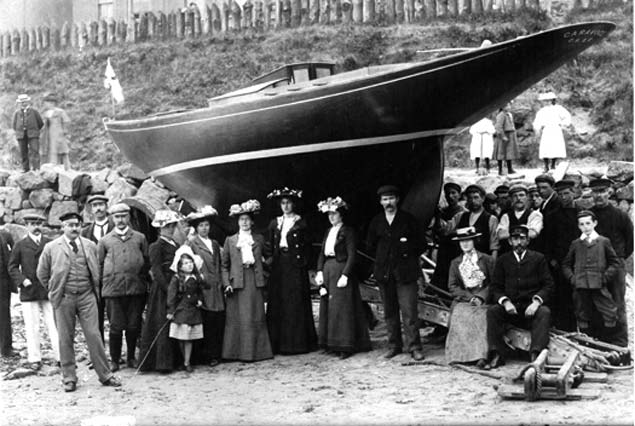 The launching of the new James Kelly-built Dublin Bay 21 Garavogue at Portrush in 1903. The original owner was W R Richardson. Photo courtesy Robin Ruddock
The launching of the new James Kelly-built Dublin Bay 21 Garavogue at Portrush in 1903. The original owner was W R Richardson. Photo courtesy Robin Ruddock
Sailing was one of them, and during the 1930s, The Lord owned and regularly raced the Dublin Bay 21 Garavogue, originally built by James Kelly of Portrush in 1903. She was well worn by the 1930s, thus it was Lord Glenavy who – at a Committee Meeting of the Royal Alfred Yacht Club in 1934 – first suggested the formation of a new, larger Bermuda-rigged One-design class for Dublin Bay.
This in time became the Dublin Bay 24s. But as the interruptions of World War II meant they didn’t have their first race until 1947, by this time Glenavy was getting near the end of his sailing career, and it concluded with the sale of Garavogue. Nevertheless, during his time with the boat, he and his family were very much involved with the class, and in his later writing, Patrick Campbell recalled how, on the rare enough occasions when Garavogue did very well, his father would exasperatingly delay going ashore after racing in order to take time out to mark all sheets with bits of brightly-coloured wool to show exactly how the sails had been trimmed when the boat was winning.
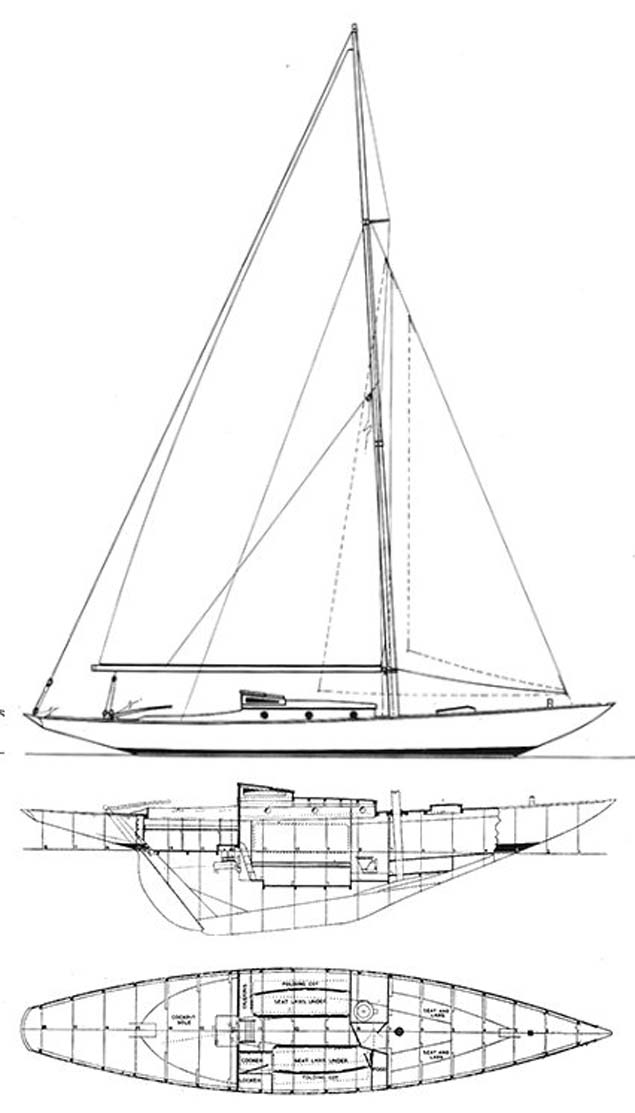 Plans for the Dublin Bay 24. The concept for a new class was originally suggested by Lord Glenavy at a Committee Meeting of the Royal Alfred YC in Dun Laoghaire in 1934, but by the time these plans were finally agreed and construction had started, World War II was looming, and the class was not to race in Dublin Bay until 1947.
Plans for the Dublin Bay 24. The concept for a new class was originally suggested by Lord Glenavy at a Committee Meeting of the Royal Alfred YC in Dun Laoghaire in 1934, but by the time these plans were finally agreed and construction had started, World War II was looming, and the class was not to race in Dublin Bay until 1947.
Needless to say, despite meticulously replicating the sail trim next time out, Garavogue would disappointingly fail to perform. But the boat and the class provided a source of anecdotes for Patrick Campbell’s subsequent humorous writing, with the annual Wicklow Regatta in particular providing a rich seam of narrative.
Long after he’d left Ireland to work first in England and then base himself happily with his third wife in the south of France while still continuing to produce gems of style and wit, he heard from Dublin Bay 21 enthusiast Fionan de Barra that Garavogue was still very much in existence, and wrote back with a contribution for a book (which will appear in due course) on the Dublin Bay 21s, and telling of his pleasure of learning of the boat’s continuing life, as he had long since assumed she’d become “a sturdy hen-house”.
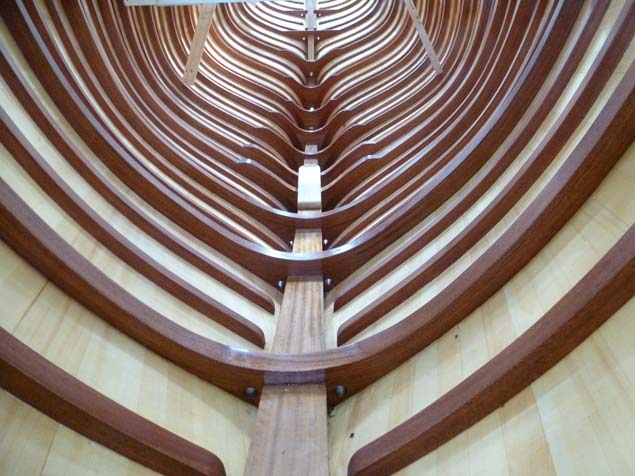 Rather more than “a sturdy hen-house”. The exquisitely-restored hull interior of Garavogue as seen in Kilrush Boatyard last September. Photo: W M Nixon
Rather more than “a sturdy hen-house”. The exquisitely-restored hull interior of Garavogue as seen in Kilrush Boatyard last September. Photo: W M Nixon
In later years, his career blossomed, for although he’d been educated in England, he never lost his Irish accent which was emphasized in television appearances (he was a star of panel and game shows), a pleasant accent which was emphasised by his sometimes total stammer, which he preferred to describe as “an attractive speech impediment”. He would emerge as cool as you please from ferocious bouts with it, while everyone around him had been reduced to acute nervous tension.
 Dublin Bay 21 sailor Patrick Campbell. He eventually found his metier as a “universal humorous writer” and a television performer, noted on screen for his relaxing Irish accent and a stammer which he preferred to think of as “an attractive speech impediment”
Dublin Bay 21 sailor Patrick Campbell. He eventually found his metier as a “universal humorous writer” and a television performer, noted on screen for his relaxing Irish accent and a stammer which he preferred to think of as “an attractive speech impediment”
In his extensive writings he wasn’t above a bit of Paddywhackery when writing about his erstwhile countrymen, which may partially explain who he is no longer as well-known here as he should be. But in mitigation, it should be said that the Paddy who was dealt the greatest whackery in his often wickedly funny writing was Paddy Campbell himself.
And ultimately he was Everyman, faced with the problems of being an accident-prone giant struggling to get through life with a modicum of dignity and subsequent humour. Thus although this piece – A Stallion Sneeze - about the hazards of extreme sneezing from the early 1960s begins with a reference to King’s Road in Chelsea at a time when Swinging London was coming to life, it was written in France, it is universal in its relevance, and it is very timely for our current situation.
A STALLION SNEEZE
I had written:
‘At eight o’clock on a Sunday morning King’s Road in Chelsea is a desolate waste of litter – old newspapers, ice cream cartons, torn shopping bags, cigarette ends by the million -’
Then I got this tremendous sneeze.
It was one of those sneezes the preliminaries of which seem to go on for ever. At one minute I was sitting there writing about litter in Chelsea and the next I was in the grip of a cosmic force so powerful that without straining itself in any way it began to change my whole physical shape. I began to feel like putty being moulded by a huge glazier.
First, this giant force got to work upon my jaws and mouth, pressing out and hardening this delicate machinery until, with the teeth bared and the upper lip drawn back, I must have looked like Silver, the mad white stallion, about to do something unpleasant.
At the same time this frightful pressure squeezed my eyes shut and then shoved them along the Eustachian tubes into my ears, where they flung themselves against the drums, trying to get out.
This displacement of the eyes led almost immediately to a change in the shape of the top of my head. It began to rise into a point, with the subsidiary effect of drawing me right up into the top left-hand corner of my high-backed chair, so that it seemed that I retained a grip upon the floor only with a single toe.
For some time I held this pose, levitating, teeth bared, lips curled, nostrils flaring, ears gone, eyes bursting and nails dug deep into the upholstery. Then everything blew up.
The actual explosion was preceded by a wild cry of mindless terror – a long drawn out yell sounding something like ‘AAAAAAGH’ – and then it burst.
I was surprised by the damage, except of course that the circumstances were rather special.
Just before I’d written the words about the litter in King’s Road I’d slipped half a large tomato, peppered and salted, into my mouth, where it joined a partially chumbled biscotte – one of those roasted bread slices which the French do so well. Into this mixture I then injected a mouthful – or as much of a mouthful as possible – of black coffee.
It was a tight fit but it would have been a viable proposition if it hadn’t been for the sneeze.
The whole business – typing with the mouth bursting with breakfast – came from being suddenly seized with an idea, after being dazzled for too long by the glare of an empty page. I felt I needed this last mouthful of breakfast, to sustain me, while at the same time rattling out the first sentence, before it got away.
Anyway, it burst.
For a moment I thought I’d blown the front of my face off. There was this awful feeling of everything coming away. I almost got my handkerchief to the site of the explosion and then there came another one, louder, wilder, infinitely more destructive than the first.
I lay back in my chair, spent, drained of everything, waiting for the third eruption – the one which would deprive me of my backbone, shooting it out through my nose in a spray of tinkling vertebrae which would probably smash the window on the other side of the room.
It turned out that we’d finished. These two major explosions, one even bigger than the other, were to be our portion for the day.
But at what a cost.
The extremely high muzzle velocity of the breakfast had enabled it to reach and to penetrate every corner and crevice of the room. It had got to the bookshelf and the Modigliani reproduction above it. It was on the door, the ceiling and all four walls. It was in the typewriter. It had even struck a portrait of me painted by an aunt of mine in 1954, where it had obliterated one eye. The other one stared at me in outrage.
I sat there, huddled in my chair, tomatoed, thinking what bad luck it all was. I was thinking that if Tolstoy had got one of those we wouldn’t have had War and Peace. A couple of those for Dickens would have meant curtains for both Dombey and his son.
I set to to clean up, sorry for the world that now would never hear about the surprising amount of litter in King’s Road at eight o’clock on a Sunday morning.
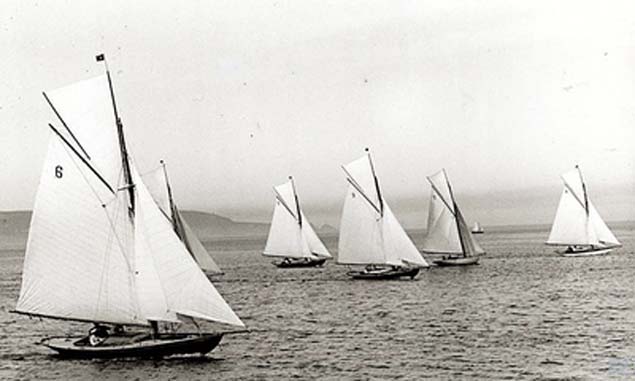 The Dublin Bay 21 Class racing, with Naneen – now restored for Hal Sisk and Fionan de Barra – in the foreground. On the rare enough occasions when the Campbell family’s Garavogue did well, Lord Glenavy would keep everyone waiting while he used brightly-coloured wool to mark the exact setting of each sheet. Despite his efforts, almost invariably the excellent performance would not be repeated on the next outing, even with the sheets being trimmed precisely as they’d been when success was achieved
The Dublin Bay 21 Class racing, with Naneen – now restored for Hal Sisk and Fionan de Barra – in the foreground. On the rare enough occasions when the Campbell family’s Garavogue did well, Lord Glenavy would keep everyone waiting while he used brightly-coloured wool to mark the exact setting of each sheet. Despite his efforts, almost invariably the excellent performance would not be repeated on the next outing, even with the sheets being trimmed precisely as they’d been when success was achieved
Restored Dublin Bay 21s Will Start DBSC Racing in April
There has been excellent progress on the revival of the Dublin Bay Sailing Club Twenty One project the world’s oldest intact on design keelboat class as they prepare for a new season racing again on Dublin Bay.
Chris Moore of Dublin Bay Sailing Club has confirmed the original DBSC class has been granted a racing start for 2020 Tuesday evening racing starting this April.
Initially, two twenty ones will race then three as the boat building project based in Kilrush on the Shannon Estuary completes the six-boat project.
The restored boats will be welcomed back to the bay in a special DBSC gun salute from committee boat Mac Lir at the start of the season.
Back to the Future
You can join the '21 project leaders Hal Sisk and Fionán de Barra for a sailing talk and a two-course dinner on Thursday the 13th of February in the RStGYC Dining Room in Dun Laoghaire. The talk, “Back to the Future, the Revival of the DBSC Twenty Ones—the World’s Oldest Cruiser Racer Class" will be a visual presentation on the revival plans.
Dublin Bay 21 'Naneen' is Drop Dead Gorgeous
“They are drop dead gorgeous.” Those words came to mind this week when, amongst the collection of many Emails, phone texts and post that arrive each week there was a photograph which nicely illustrated those words.
Stephen Morris sent me from Kilrush the photograph here of the first sailing of the Naneen, the Dublin Bay 21, that I last saw at Kilrush on the morning she was returned to the water after her restoration led by Stephen.
“Thought you might enjoy this,” he wrote and I responded: “Beautiful would be an understatement.”
My colleague, our wordsmith-of-sailing-record, WM Nixon, will tell the detailed story of this “first” sail in his Afloat blog this Saturday, so suffice for me to say that Hal Sisk and Fionán de Barra had a magical day after they traversed across an icy morning on Naneen’s deck on Monday to go sailing. When I saw the photos those words I quoted at the outset were so apt, from a maritime discussion of which I was part at Kilrush when Naneen was re-launched and which I’ve waited for the opportunity to Podcast, which has come with this first.
The granddaughter of James Clancy, who built the 21s - Ann Griffin takes up the story on the Podcast below.


























